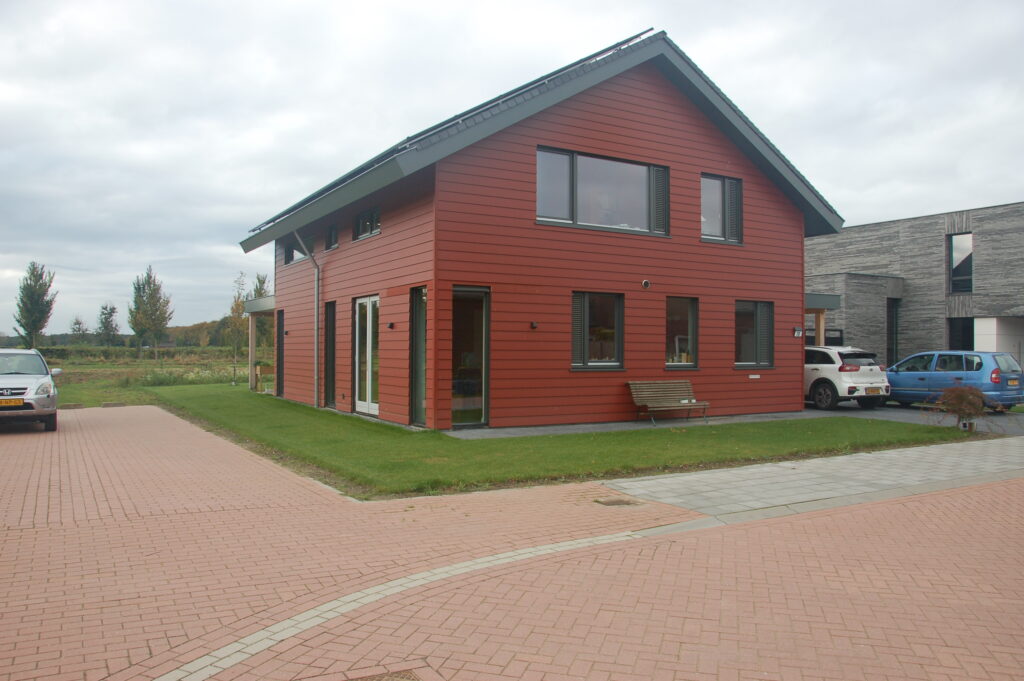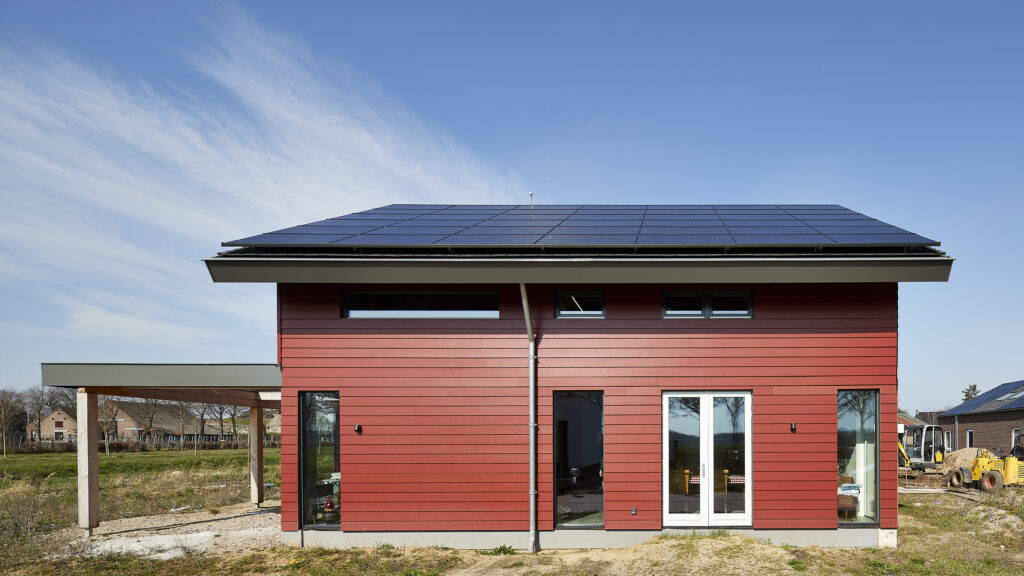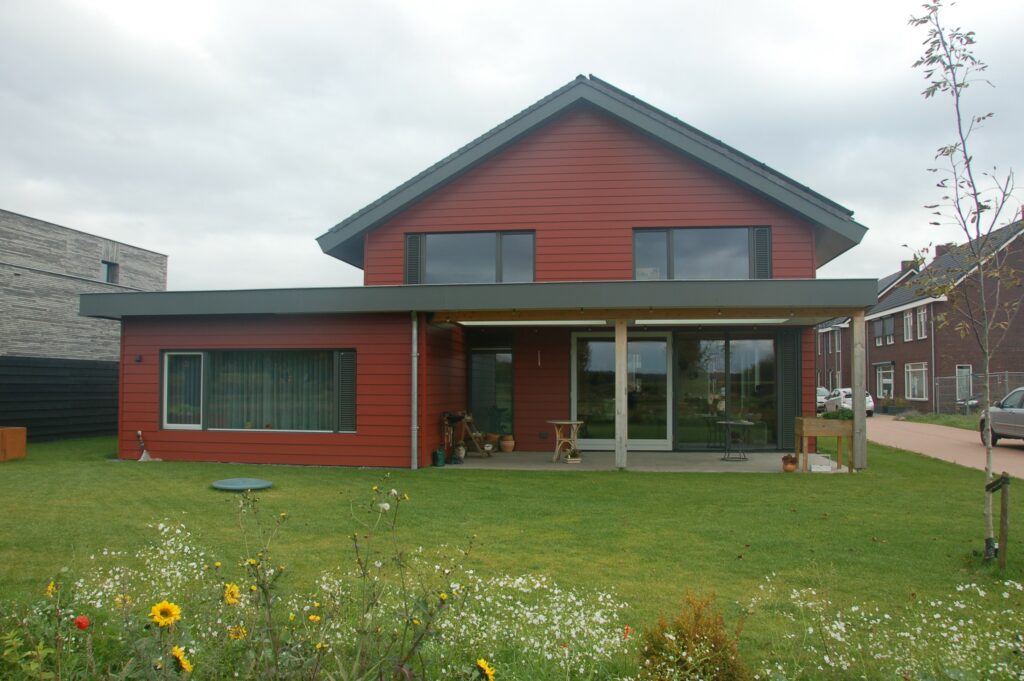029 House of Tomorrow Today 2.0
Address of the project: Hannes Kempkensweg 28, Montfort, the Netherlands
Owner/investor –
Architect: Jos Lichtenberg (both owner and architect)

House of Tomorrow Today 2.0 (abbreviated HoTT 2.0) is the follow up of a project realized in 2014. The first version was about proving that a level of liveability (indoor climate, high level of fresh air, flooded with daylight) could be obtained together with an annual energy surplus. We realized this first project for own accommodation, but also in the frame of my research as a full professor at the Eindhoven University of Technology (TU/e). At the TU/e I had a chair in building innovation.
HoTT 2.0 is our second Active house project aiming to optimize the HoTT concept and to prove its economic feasibility. The way to achieve a feasible concept was an industrial approach based on the so-called Slimbouwen (Smart building) approach. Slimbouwen, is a vision that I developed during my career at the University ever since 2003. It divides the process into four sequential chunks, namely frame, envelope, services and finishing. Especially the uncoupling of services is crucial in achieving an industrial process. This was elaborated in HoTT 2.0. Already with a series of only one house, a price reduction of 5-10% at a much higher quality level regarding indoor climate and comfort, was obtained. This is remarkable seeing most of the Active Houses being realized in a more exclusive market segment. In the Netherlands already about 150 projects are successfully developed according to the Slimbouwen conception achieving cost reduction in between 5 – 30%. It was never elaborated before, for single family houses.
HoTT 2.0 is a 220 m2 but compact designed house with a high volume/outer surface ratio. Special attention is paid to daylight all over the house (daylight level 23 (ground floor)-25% (first floor)), especially from the east, south and west façade and with quite some Velux roof windows in the northern roof. The living space is touching the east, south and west facades containing eight (!) large façade windows. Every bedroom (4) has two windows from two different orientations, including roof windows. Except for one bedroom that has only one (but real large) window. The stairwell is flooded by daylight because it is completely covered by Velux skylights. This was a late idea and real enrichment of the plan, implemented closely before commissioning. A study room contains three facade windows and one roof window (3 different orientations). A second bathroom upstairs contains a Velux roof window and in the scullery downstairs is one façade window.
The house is well ventilated by mechanical extraction and natural inlet. The ventilation is controlled by measuring the CO2 concentration per space and also by air humidity. The aim is to have a superb indoor climate keeping the CO2 concentration below 600 ppm. The extraction openings are in the kitchen, the living room, the laundry room/scullery, toilet, bathrooms (two) and the garage. The air supply is controlled by nine units (Duco Tronic) that are spread all over the house just on top of facade windows. In addition the house contains nine so-called nightvents (façade hatches). The control of these hatches is automated in order to cool down the house in hot periods by night. Part of the controlled night ventilation are also the automated Velux roof windows, that communicate with the Duco nightvents. By coupling these products a chimney effect is obtained as a driver for airflow, even if there is no wind at night.
Every window including the Velux roof windows is equipped with an automated sunscreen (16 in total). Except for one large window in the living space that is shaded by a porch and three façade windows, shaded by the roof overhang.
Another special item to reduce the heat in summertime is the fact that every surface is covered by e ventilated layer. The timber façade has all around the house a ventilated cavity, in the southern roof the underneath ventilated PV panels will function as a sunscreen for the roof. And the northern roof (still capturing a lot of solar radiation) is caried out as a double layerd ventilated so called parasol roof. By this principle the heat flux through the outer structures will only be marginal.

The physical building concept is based on a timber frame structure, with quite some space for insulation (the elements are a kind of boxes, with an interior of 220 mm available for insulation material). Analysis from the first HoTT project learned that a well-insulated shell (facades, roof and ground level floor) is important, but also that there is an optimum taking into account the limitation of thickness (to optimize the residual indoor space), the reduction of materials consumption (not only insulation, but also structural materials; for environmental reasons) and to reduce costs. Nevertheless the shell is well insulated. It also is airtight. However for liveability reasons there are quite a lot of openings to collect a lot of daylight and also to have a splendid view on the surrounding landscape. The openings (triple glazing) and also the generous ventilation are from an energetic point of view weaknesses. Even the window panes are triple glazed and the ventilation is CO2 controlled. The energy concept is however designed with a human centred vision. This means that the energy losses through windowpanes and by the extra ventilation are accepted in order to achieve a higher indoor comfort and healthy indoor climate. In the concept the losses are however compensated with solar panels on the southern roof (42 panels, 68 m2).
In practice in the first full year the system was producing 11,700 kWh (in theory this could be optimized). The heat and also the cooling in summertime is provided by a high end geothermal heat pump (EcoForest) with a COP of 4.5. The heat is distributed all over the ground level spaces by a liquid-based floor heating system controlled per room. In the study (first floor) there are two low temperature convectors. The other spaces on the first floor are only incidentally in use (guest rooms, storage) and they are electrically heated. Hot tap water is also generated with the very same heat pump.
The house is being occupied from November 2020. From the first full year could be concluded, that only in November, December and January a net suppletion of energy was required. Oktober and February were about neutral and the other 7 months there was a surplus, though the system also provides cooling in summertime. However this is logical because the need for cooling energy is limited by the night ventilation systems and the shading screens. And cooling with a geothermal heat pump is cost and energy effective. In fact we need to apply cooling in order to recuperate the source in the soil up to a depth of 80 m, preparing it for wintertime.
All in all the house showed in its first year an annual energy surplus of 4,600 kWh. The total use is 7,100 kWh. This is including the use of a full electric car and to power the heat pump. The surplus is somewhat higher than expected, but this is mainly due to covid 19. In a representative year we would probably drive an extra 20,000 km representing 2,500 kWh. Even than an annual surplus can be expected.
In the Netherlands we have a national arrangement that makes it possible to return the surplus energy to the provider to compensate energy that is requested at another moment. Therefor it is right now not attractive to use batteries for temporary storage. Change is however announced and therefor the house is prepared to install batteries as soon as they are required and feasible.

The house is build according a prefabricated timber frame structure. The complete outside layer consists of ventilated Platowood façade planks. Platowood uses fast-growing wood from sustainably managed FSC-forests. Through a refinement process (Platonising) the wood is boiled, dried and baked (hydro-thermal modification) and thereby becomes extremely durable. At the inside the structure is finished with a front panel in order to hide the services without affecting the inside air tight layer at the back of a small cavaty and against the timber frame elements. Also the roof, windows, partition walls, load bearing elements, columns, beams, part of the ceilings, outdoor finishing of roof overhangs and wall coverings are made of FSC certified wood. The first floor consists of a 80 mm thin cross laminated timber (CLT) floor every 2,1 m supported by laminated wooden beams. Also here the horizontal distribution of services is placed in a 8 cm cavity just beneath the CLT elements and above the living space finished with a FSC certified wooden ceiling. The top of the CLT elements is also the finish. Some of the ceilings and walls are finished with plasterboard and a plastering finish. In function of adaptations the fronts are divided into small sections in between windows. So in case the front wall has to be removed, the adaption or repair will always be limited.
The house captures all in all over 20,000 kg of CO2. There is no emission of fossil combustion. The total energy supply is realized with a heat pump electrically powered by 42 solar panels. There is only one exception (guilty pleasure) made for cooking. My wife had bad experiences with electrical cooking and desired a classical gas stove. Also this is part of human centred design. However, in case she changes her mind, everything is prepared for electrical cooking.
Besides the timber frame superstructure the base is mainly realized in concrete. In the Netherlands we have to deal with moist and concrete is for foundations and groundlevel floors an unsurpassed material and therefore a responsible choice. Through the light weight structure no foundation piles were required. In the local plan it is the only house without piles.
By the uncoupling of services and the structure, the house is flexible. Adaptations of the installation or rearrangements of the floorplan are easy to realize.
From the first HoTT project we learned that generating solar energy is in conflict with environmental values. The more energy is collected, the worst the environmental load will be. An analysis was made within the commonly used GPR tooling and from that we learned that despite we will cause a dent in the Active House Radar graph for environmental load, the best choice is to choose for an optimization on energy.
The house is prepared to reuse rainwater. Rainwater is collected in a tank and the overflowing water will infiltrated on the spot through underground crates. There is no sewer system for rainwater. The underground tank is collecting around 1,5 m3. This water is used to spray the garden under dry circumstances and other secondary application.


